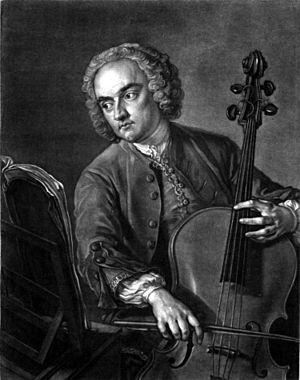John Hebden facts for kids
John Hebden (1712–1765) was a talented composer and musician who lived in Great Britain during the 1700s.
Not much is known about John Hebden's early life. He was born in 1712 near Harrogate in Yorkshire. He lost his parents when he was young. Luckily, he received a great education, which included music lessons.
Contents
Early Life and Family
John Hebden spent most of his life in the city of York. In 1732, he married Mary Prestland. Their first son, also named John, was born in 1733 but sadly did not live long.
Another son was born in 1736. However, Mary, his wife, passed away shortly after in 1737. John Hebden then had to raise his young son while working hard to earn enough money. He made sure his son would have money for the future.
Moving to London and Musical Career
Around 1742, John Hebden moved to London. In 1745, a famous composer named Thomas Arne made his orchestra bigger at a popular place called Vauxhall Gardens. Hebden became the main cellist and bassoon player there.
He also played in a performance of Messiah, a famous piece of music. This performance was led by the well-known composer George Frideric Handel himself. The concert helped raise money for the Foundling Hospital, a home for children.
John Hebden was mainly an orchestra player. He was a professional bassoonist, gamba (viol) player, and cellist. In the 1730s, he wrote music for a small local orchestra in York. This orchestra had "all the best Hands in Town," meaning the best musicians. They performed many concerts at the York Assembly Rooms. These rooms were designed by Richard Boyle, who was a supporter of Handel.
Hebden's Compositions
It seems John Hebden wanted to do more with his musical talent. He focused his creativity on more serious musical works. Only two of his collections of music were published during his lifetime. These were his Six Solos for German Flute and his Six Concertos for Strings.
The Six Concertos for Strings
Hebden likely started writing his Six Concertos for Strings around 1745. They were published about 1749. About 500 copies were made. Many important people bought copies, including the Earl and Countess of Burlington. Academics and organists also bought them. Even taverns like The Devil and The Globe in Fleet Street, where concerts were held, bought copies.
Famous actor David Garrick, who put on many of Shakespeare's plays, also bought a copy. Some of Hebden's fellow musicians from Vauxhall, like Valentine Snow, were also subscribers. Other composers, such as Thomas Arne and William Boyce, also supported his work.
Today, only six copies of this original edition have survived. Two are in London, one in Brussels, and three in the United States. An incomplete set is also kept in a private collection in Durham.
Rediscovering Lost Music
These six concertos were only found fairly recently. In 1980, a music consultant named Ruzena Wood became interested in Hebden. She had studied his First Sonata for Flute and Keyboard. She then started looking for any string music he might have written.
Finally, she found the six forgotten concertos in the library of the British Museum. They had been sitting there, unplayed, for 200 years!
Style of His Music
Hebden's Concertos are written in the Baroque style. In this style, composers often wrote happy music using sharp keys and sad music using flat keys. His concertos were greatly influenced by the Italian composer and violinist, Geminiani. Geminiani came to England in 1714.
The concertos are written for seven parts: four violins, a viola, a cello, and a harpsichord. Two of them (No. 2 in C major and No. 3 in C minor) have three movements. The others have four movements. The fast parts of his music have lively dance rhythms. While these sound Italian, they also remind listeners of English country dances. Hebden would have known these dances from his time in Yorkshire.
Surviving Works
John Hebden's only works that we still have today are:
- His 6 concertos for strings (Op. 2):
- No. 1 in A Major
- No. 2 in C Major
- No. 3 in E minor
- No. 4 in E Flat
- No. 5 in C minor
- No. 6 in D minor
- His 6 solos for flute and harpsichord.


